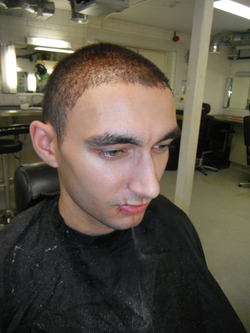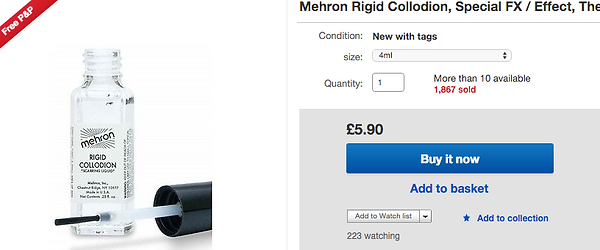EMMA FREEMAN
SPECIALIST PRACTICE
Flock:
I was really pleased with the overall look of the flock, I used 14mm in length and a mixture of black and brown. Any longer I feel it may not have looked as realistic and any shorter would have not made as much as an impact for his transformation. The brown colour looked slightly too much of a red tone, so for this I would seek various colours with a more grey brown to suit his eyebrows and natural colouring.
Another error I made was the placement of hairline. After I had flocked my first section I felt the right side needed to be brought forward. I added more prosade and flocked on top, this created a visible seam as you can see in the image to the right. In the future I will fock all in one go, and be more careful with the placement of the prosade.
Flocking is a safe way to adhere fibres which will be embedded vertically in adhesiive such as prosade. A low pressure air can be used to direct hairs in a particular direction to mimic the growth pattern, Make sure to tell your model to close their eyes and mouth when flocking.
For this design I wanted to give Lukaz a more youthful look so that I could show his before and after appearance during his time in prison. To experiment with hairlines I wanted to bring his forward (as he naturally has a receding hairline)
I asked lukaz to shave before hand and practised the technique of flocking on him. As I only needed a small amont for my experiment I managed to purchase a sample from another student for £2. I was surprised in how realistic this looked on Lukaz, it really transformed his appearance.
As I wanted to create some sort of ropes around the mouth, or some deep scars I practised using collodian and illustrator pallette to colour. Collodian was a cheap alternative to sculpt gel or the making of flat pieces as it cost £5.90. I had seen some effective results during my research so I wanted to experiment using it.
 |  |
|---|---|
 |  |
 |  |
EXPERIMENTATION DESIGN 1




http://3.bp.blogspot.com/_wCbWQx333ys/TJjZqbKXCNI/AAAAAAAAANg/iKBCkVDCydo/s1600/Picture+3297.jpg (Accessed: 27 December 2015).
Electronics, cars, fashion, collectibles, coupons and more (no date) Available at: http://www.ebay.co.uk/ (Accessed: 27 December 2015).
CRITIQUE/HOW TO IMPROVE-

FLOCKING
Debreceni, T. (2013) Special makeup effects for stage and screen: Making and applying Prosthetics. 2nd edn. United Kingdom: Taylor & Francis.




Practising using different quantities of hair for thickness and airbrushing into the correct direction
Scars:
The collodian was effective in creating scars, however, I would have liked to have built up more on the areas to create a deeper looking scar. I did not add any more as my model told me the liquid was quite strong and irritating his mouth. I decided to let it dry and continue colouring with illustrator and alcohol. The colours used were a little too orange. I need to practise my colouring techniques and find more real life reference images to help me with colour placement

REFLECTION:
After further research into how to use the collodian I have learnt layering up the product makes a big difference to ts effect. This artist has also used grease paints to paint the scars which gives them a more opaque look making them stand out from the other parts of the skin. They have used white and flesh tones, applied where the borders of the scar and the model's skin meet
A complete guide to special effects makeup: Conceptual artwork by Japanese makeup artists (2007) Japan: Graphic-Sha Publishing.